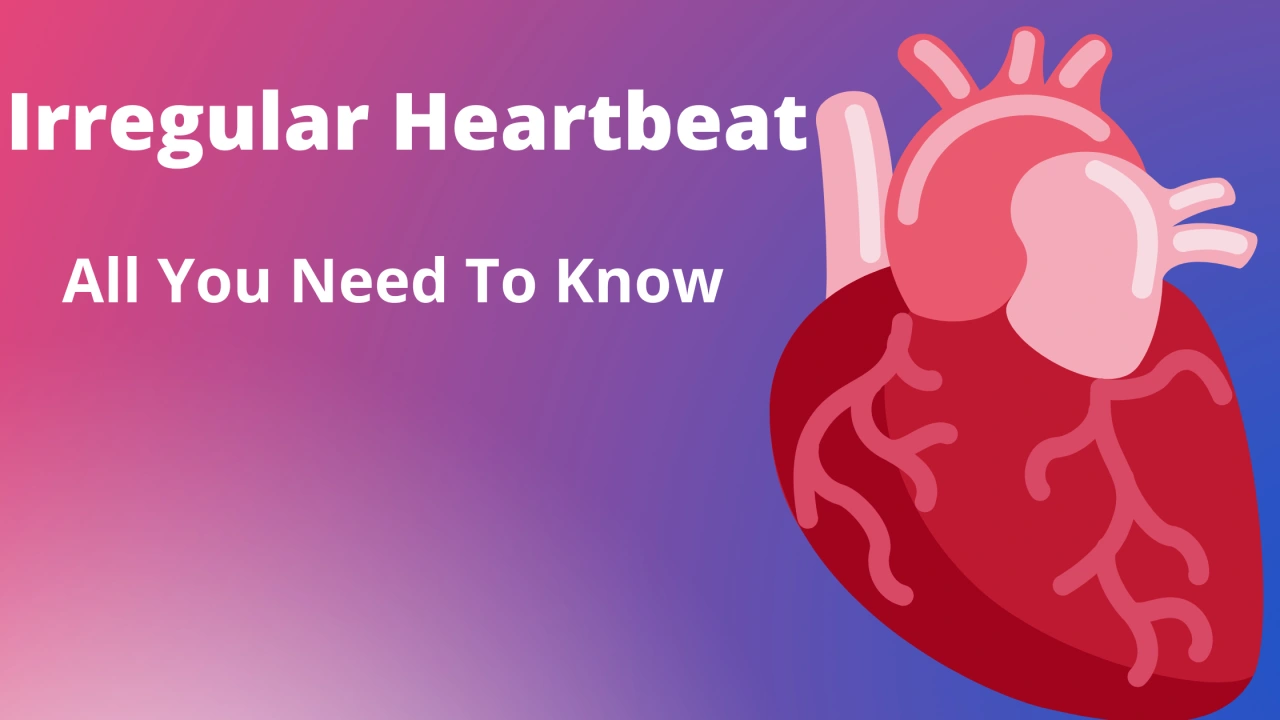What is Irregular Heartbeat (Atrial Arrhythmias): The Ultimate …

Without a regular heart rate and rhythm, the heart may not perform efficiently as a pump to circulate oxygen-rich blood and other life-sustaining nutrients to all of the body’s tissues and organs i.e. including the heart itself.
With an irregular or erratic rhythm, the heart is considered to be dysrhythmic (sometimes called arrhythmic). This is a potentially dangerous condition.
What is an Arrhythmia (Dysrhythmia)?
Arrhythmia(dysrhythmia) is defined as an abnormality in the rhythm of the heartbeat. It means your heart beats too slowly or too quickly or with an irregular pattern.
When the heart doesn't beat properly, it can't pump blood effectively.
When the heart doesn't pump blood effectively, the lungs, brain, and all other organs can't work properly and may shut down or be damaged.
When the heart beats faster than normal, it is called tachycardia.
When the heart beats too slowly, it is called bradycardia.
Types Of Arrhythmias (Dysrhythmias)
Arrhythmias are named according to the site of the origin of the impulse and the mechanism of formation or conduction involved.
For instance, an abnormality that originates from the Sinoatrial (SA) node and at a slow rate would be called sinus bradycardia, and at a faster-than-normal rate would be called sinus tachycardia.
Arrhythmias (dysrhythmias) include:
Sinus Node Arrhythmias
Atrial Arrhythmias
Ventricular Arrhythmias
Junctional(AtrioVentricular Node) Arrhythmias
Atrial Arrhythmias (Dysrhythmias)
Atrial arrhythmias are disorders of your heartbeat or rhythm that originate from the upper part or chambers(atrial) of the heart or in nearby tissues.
This article is about atrial arrhythmias: we’ll discuss the types, signs, and symptoms, and treatments, etc.
There are three(3) types of atrial arrhythmias:
Atrial Fibrillation (AFib or AF)
Premature Atrial Complex(PAC)
Atrial Flutter
Atrial Fibrillation (AFib Or AF)
The term atrial fibrillation is formulated from two words: atrial meaning the upper part of the heart and fibrillation which means quivering.
Atrial fibrillation is a quivering or irregular heartbeat (arrhythmia) that can lead to blood clots, stroke, heart failure, and other heart-related complications.
About 2.7 million Americans are living with AFib.
During atrial fibrillation, electrical impulses are triggered from many areas in and around the atria rather than just one area.
With atrial fibrillation, your heart rate may range from 100 to 175 beats a minute. The normal range for a heart rate is 60 to 100 beats a minute.
Causes Of Atrial Fibrillation
The exact cause of atrial fibrillation is not known, it mostly originates not in the atrium but in nearby tissues (e.g. the pulmonary vein).
Possible causes of atrial fibrillation include:
Coronary artery disease
Heart attack
A heart defect that you're born with (congenital heart defect)
Heart valve problems
High blood pressure
Lung diseases
Physical stress due to surgery, pneumonia, or other illnesses
Previous heart surgery
Problem with the heart's natural pacemaker (sick sinus syndrome)
Sleep apnea
Thyroid diseases such as an overactive thyroid (hyperthyroidism) and other metabolic imbalances
Use of stimulants, including certain medications, caffeine, tobacco, and alcohol
Viral infections
Risk Factors Of Atrial Fibrillation
Things that increase the likelihood of getting atrial fibrillation:
Increasing age
Male gender
Higher Body Mass Index
Systolic blood pressure more than or equal to 160mm Hg
Hypertension
Heart Failure, etc.
Signs And Symptoms Of Atrial Fibrillation
Some people who have AFib are unaware of it and don’t have any symptoms. Others may experience one or more of the following symptoms:
Irregular heartbeat
Heart palpitations (rapid, fluttering, or pounding)
Lightheadedness
Extreme fatigue
Shortness of breath
Chest pain
Common Diagnostic Investigation For Atrial Fibrillation
Several tests can help your doctor diagnose arrhythmia and monitor the effectiveness of your treatment.
Electrocardiography(ECG). The most common test used to diagnose an arrhythmia is electrocardiography (EKG or ECG). Your doctor will run other tests as needed.
Echocardiography, provide information about the size and shape of your heart and how well it is working.
Thyroid Function Test. This helps to check for thyroid hormone levels and the functioning of your liver and kidneys.
Treatment of Atrial Fibrillation
Atrial fibrillation is treated with lifestyle changes, medicines, and procedures, to help prevent blood clots, slow your heartbeat, or restore your heart’s normal rhythm.
Lifestyle Changes:
Adopting the DASH plan, which reduces salt intake to help lower blood pressure.
Managing stress
Quitting smoking
Avoiding alcohol intake
Being physically active and reducing your weight.
Medicines:
Your doctor may consider treating your atrial fibrillation with medicines to slow your heart rate or to make your heart’s rhythm more even:
Beta-blockers, such as metoprolol, carvedilol, and atenolol, all help to slow the rate at which the heart’s lower chambers pump blood throughout the body.
Blood thinners, help to prevent blood clots and lower the risk of stroke. These medicines include edoxaban, dabigatran, warfarin, heparin, and clopidogrel
Digitalis, or digoxin, controls the rate blood is pumped throughout the body. It should be used with caution, as its use can lead to other arrhythmias.
Other treatments
Besides lifestyle modification and medications, your doctor may also book you for surgery. Procedures normally used are catheter ambulation, cardioversion, pacemakers, etc.
Atrial Fibrillation and Stroke
Atrial Fibrillation is growing in prevalence and is linked to an increased risk of stroke, dementia, and premature death. Strokes caused by complications from AFib tend to be more severe than strokes with other underlying causes.
Strokes happen when blood flow to the brain is blocked by a blood clot or by fatty deposits called plaque in the blood vessel lining.
Premature Atrial Complex (PAC)
Premature Atrial Complex(PAC) or premature beats occur in many healthy people and rarely cause symptoms. Atrial premature beats are common among people who have lung disorders (such as chronic obstructive pulmonary disease) and are more common among older people than among younger people.
It occurs when an electrical activity of the heart starts in the atrium before the next normal activity(impulse) of the sinus node.
Causes Of Premature Atrial Complex (PAC)
PAC may be caused by:
Caffeine
Alcohol
Nicotine
Stretched atrial myocardium (e.g in high blood level in the body)
Anxiety
Low potassium level, etc.
Signs And Symptoms Of PAC
Atrial premature beats rarely cause symptoms. Some people do experience palpitations.
The client may say: “My heart skipped a beat”
An unusually strong heartbeat
A pulse deficit may also exist
Common Tests For Premature Atrial Complex
Atrial premature beats may be detected during a physical examination and are confirmed by electrocardiography (ECG).
Treatment Of Premature ATrial Complex
PACs may not require treatment. If PACs are infrequent, no treatment is necessary.
Sometimes antiarrhythmic drugs are prescribed.
If a cause is identified it’s treated
Atrial Flutter (AFL)
Atrial flutter is similar to AFib because it also occurs in the upper part of the heart and can result in a fast heartbeat.
During atrial flutter, unlike in atrial fibrillation, electrical activity in the atria is coordinated. Thus, the atria do contract, but at a very rapid rate (250 to 400 times per minute).
This rate is too fast to allow every impulse to be conducted through the atrioventricular node to the ventricles.
Causes Of Atrial Flutter (AFL)
Atrial flutter often occurs in patients with:
Chronic Obstructive Pulmonary Disease
Pulmonary Hypertension
Valvular disease
Thyrotoxicosis, as well as
Following heart surgery, and
Repair of cardiac congenital defects
Signs And Symptoms Of Atrial Flutter (AFL)
People with AFL usually continue to have a steady heartbeat, even though it is faster than normal. People with AFL may feel no symptoms at all. Some do experience symptoms, which may include:
Feeling tired and not having enough energy
Heart palpitations (feeling like your heart is racing, pounding, or fluttering)
A fast, steady pulse
Shortness of breath
Having trouble with everyday exercises or activities
Pain, pressure, tightness, or discomfort in your chest
Dizziness, feeling lightheaded, or fainting
Risk Factors Of Atrial Flutter (AFL)
Atrial Flutter is not a common arrhythmia. It is much less frequent, for instance than atrial fibrillation. People who are more prone to develop atrial flutter include:
Obesity
Lung disease
Sleep apnea
Sick sinus syndrome
Pericarditis
Hyperthyroidism
History of heart surgery
Common Diagnostic Investigations For Atrial Flutter
Symptoms suggest the diagnosis of atrial flutter, and electrocardiography (ECG) confirms it.
Ultrasonography of the heart (echocardiography) is done. It enables doctors to evaluate the heart valves and look for blood clots in the atria.
Doctors usually also do blood tests to look for an overactive thyroid gland.
Common Treatment Of Atrial Flutter
Treatment of atrial flutter is designed to:
Control the rate at which the ventricles contract,
Restore the normal rhythm of the heart, and
Treat the disorder causing the arrhythmia.
Anticoagulants, such as warfarin, or a short-acting anticoagulant like heparin may be given.
Also, ablation procedures designed to interrupt the atrial reentrant circuit may effectively prevent atrial flutter, particularly typical atrial flutter.
Summary
Arrhythmia is caused by changes in the electrical activity of your heartbeat.
These changes can be caused by damage from disease, injury, or genetics.
Often those who've it are symptoms free, but some people feel an irregular heartbeat.
You may feel faint or dizzy or have difficulty breathing. You should consult your doctor if you feel any of these symptoms
References
Like this project
Posted Jun 17, 2023
Without a regular heart rate and rhythm, the heart may not perform efficiently as a pump to circulate oxygen-rich blood and other life-sustaining nutrients to …








